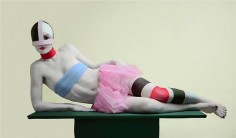SOPHIE DUPONT
Abstract Performance
source: sophiedupont
Sophie Dupont – on painting, video and performance
Sophie Dupont flirts with painting. She simultaneously challenges and works within the specific conditions that constitute the medium with an eye to the long art historical traditions that inform it.
Although Dupont’s recent works span very different media such as painting, video and performance, they clearly spring from the same components and examine the same themes.
Dupont explores the liminal space between abstraction and realism, motion and stillness, action and non-action, as well as form and content.
In Acrylic on Paper, a series of small paintings, we are presented with a universe of carefully chosen colors, combined with a series of basic geometric shapes. At first glance, the paintings seem to be extensions of the abstract modernist art of the early 20th century: the compositions are reductive and formal, the works devoid of narrative and symbolism and the palette is relatively restricted. However, several other things are at play in Dupont’s work. The geometric shapes and lines have been made without a ruler or compass and the edges of the paper have been carelessly torn, creating a spontaneous and informal quality. Paint has been applied in pastose layers without attempt to cover up individual brushstrokes, as if to highlight the works’ specific painterly and textural qualities.
Dupont does not aim for precision and perfection in her geometric compositions. Her works seem instead to explore the potential in the space that opens up between the individual shapes and the limited palette. While formally probing, the works are also alluringly poetic, a quality which unfolds in the works’ delicate expression. Each individual work constitutes a compositional whole, each insisting on exploring the relationship between shape and color in different ways.
Repetition and the continued exploration of the specific visual language are key in Dupont’s practice. The paintings are presented as a series that has come into being over the course of several years, and that constantly evolves and produces new meanings as new works are added. The project is thus potentially indefinite and the sustained repetition of colors and shapes seems almost meditative.
Dupont’s video and performance works take as their starting point the abstract pictorial universe of her paintings. Shapes, lines, and colors are translated into costumes worn by the artist. Dupont enters the abstract world of the painting and lets herself become absorbed in it: here, body and costume become the central objects, and the artist too becomes a part of the composition on the same terms as its other elements.
The video and performance works contain no plot, no story, no narrative progression – only body, composition, color and form.
Dupont appears to want to convey a state or a moment, rather than a narrative. Viewers experience the works as tableaux vivants, as small, autonomous paintings in motion. The effect is a meditative state, in which only small unavoidable movements are present: the flicker of an eye and the rhythmic movement of the chest, which reveals breathing.
From her position in the live painting, Dupont looks at us – or perhaps looks into space – with a direct, confrontational gaze, demanding our attention. Does she want something from us? The relationship between work and spectator is challenged by Dupont’s insistent gaze; we are not merely viewing the work, but potentially also being viewed. The work’s tightly composed aesthetic is infused with the feelings of ambivalence that accompany being observed.
In contrast to the spontaneity and deliberate imperfections, characterizing the paintings, the video and performance works are carefully staged and controlled.
While the video works – like the paintings – draw lines to the abstract modernist avant-garde, they simultaneously bear witness to Dupont’s multifaceted universe, which is rich in references. The aesthetics of the videos and the execution of the costumes bring to mind references as disparate as Matthew Barney’s or Leigh Bowery’s fascinating and disconcerting universes, historic avant-garde theatre, fashion photography and “primitive” art, to mention a few. The artist’s sources of inspiration are manifold, and from these she creates her own highly abstracted complex images – or states – in which many references can be found, but no single conclusion can be drawn.


